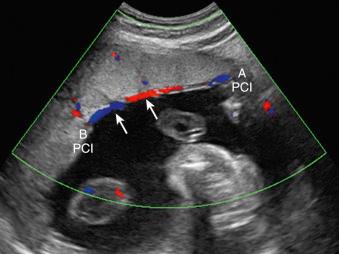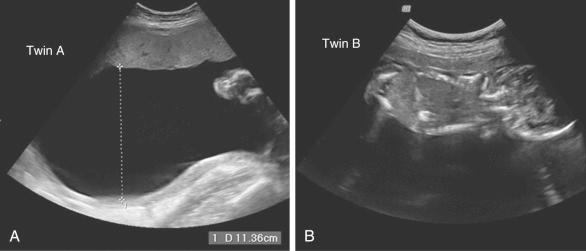Physical Address
304 North Cardinal St.
Dorchester Center, MA 02124
Twin-twin transfusion syndrome (TTTS) is a serious condition that can complicate twin pregnancies with monochorionic diamniotic (MCDA) placentation. MCDA twin pregnancies should be monitored for TTTS with serial ultrasound (US) scans beginning in the second trimester. Early-stage TTTS can be managed conservatively, but because of the unpredictable risks of disease progression and intrauterine fetal demise, prenatal testing and delivery before term should be considered. Limited data from randomized trials and retrospective experience suggest that fetoscopic laser photocoagulation may be the best available treatment for advanced TTTS diagnosed in the second trimester. Despite the availability of laser treatment, a significant risk of twin demise and neurologic handicap remains among survivors. Early detection, intervention for advanced disease, serial surveillance, and timed delivery can improve the prognosis for TTTS.
TTTS is diagnosed prenatally by US and staged based on various US findings. The initial staging of TTTS, as described by Quintero et al., was judged to have prognostic significance and thought to provide a method to compare outcome data between different therapeutic interventions. Although the staging system may not correlate perfectly with perinatal survival, it improves communication between patients and providers and identifies a subset of cases that may benefit from treatment. TTTS has five stages ranging from mild disease with isolated discordant amniotic fluid volume to severe disease involving demise of one or both twins ( Table 162.1 ).
| Ultrasound Parameter | Staging Criteria | |
|---|---|---|
| Stage I | MVP of amniotic fluid | MVP <2 cm in donor sac; MVP >8 cm in recipient sac |
| Stage II | Fetal bladder | Nonvisualization of fetal bladder in donor twin over 60 min of observation |
| Stage III | Umbilical artery, ductus venosus, and umbilical vein Doppler waveforms | Absent or reversed umbilical artery diastolic flow, reversed ductus venosus a-wave flow, pulsatile umbilical vein flow |
| Stage IV | Fetal hydrops | Hydrops in one or both twins |
| Stage V | Absent fetal cardiac activity | Fetal demise of one or both twins |
In general, only twin gestations with MCDA placentation are at significant risk for TTTS. The number of TTTS cases is increasing secondary to the increase in monozygotic twinning associated with in vitro fertilization. Overall, about two-thirds of monozygotic twins are MCDA, and 8% to 15% of these pregnancies develop TTTS. TTTS is rare in monozygotic twins with dichorionic or monoamniotic placentation.
The presentation of TTTS is highly variable, and TTTS does not always progress in a predictable manner. The natural history of advanced TTTS is bleak, with reported perinatal loss rates of 70% to 100%, particularly when disease manifests early in gestation. It is estimated that TTTS accounts for 15% to 20% of the total perinatal mortality in twins and for about half of all perinatal deaths in MCDA twins. Although TTTS may manifest at any point in pregnancy, most cases are diagnosed in the second trimester. Without treatment, the loss of at least one fetus is very common with significant risk of co-twin demise or neurologic handicap in cases of co-twin survival. Overall, single twin survival rates in TTTS vary widely between 15% and 70%, depending on gestational age at diagnosis and the severity of disease. However, two-thirds of early-stage TTTS remains stable or regresses without invasive interventions. The lack of predictability of TTTS poses a significant challenge to clinicians caring for MCDA twins.
Although the pathophysiology of TTTS is not completely understood, intertwin vascular connections within the placenta are critical for its development. Virtually all MCDA placentas have anastomoses that link the circulations of the twins, yet not all MCDA twins develop TTTS. There are three main types of anastomoses in monochorionic placentas: venovenous anastomoses (VVA), arterioarterial anastomoses (AAA), and arteriovenous anastomoses (AVA). AVA are found in 90% to 95% of MCDA placentas, AAA are found in 85% to 90%, and VVA are found in 15% to 20%.
Both AAA and VVA are superficial connections on the surface of the placenta with the potential for bidirectional flow ( Fig. 162.1 ). AVA are deep within the placenta and can result in unidirectional flow from one twin to the other and, if uncompensated, may lead to an imbalance of volume flow between the twins. In contrast to AAA and VVA, which are direct vessel-to-vessel connections, AVA are linked through large capillary beds deep within a cotyledon. AVA are believed to be essential, but not sufficient alone, for the development of TTTS, which explains why they have been found in more than 90% of MCDA placentas with TTTS and in more than 90% without TTTS. These deep AVA are usually multiple and overall balanced by AVA coursing in the opposite direction so that TTTS does not occur. Although the number of AVA from donor to recipient may be important, their size and placental resistance likely influence the volume of intertwin transfusion that occurs. Placentas in cases of TTTS are also more likely to have VVA but less likely to have AAA. It is thought that AAA may compensate for the unidirectional flow through AVA, preventing the development of TTTS or decreasing its severity when it does occur. Mortality is highest in the absence of AAA and lowest when these anastomoses are present. However, the presence of AAA is not completely protective because 25% to 30% of TTTS cases also have these anastomoses. Although chronic TTTS seems to be the result of deep AVA, acute TTTS may occur when there is rapid intertwin transfusion through superficial anastomoses. This uncommon complication, referred to as twin anemia-polycythemia sequence, is most often observed at the time of delivery and is rarely detected prenatally.

Although the primary problem lies with the placenta, additional factors beyond placental morphology appear to be involved in the development of TTTS. The simple imbalance of blood flow through placental anastomoses may lead to a more complex interplay between fetal adaptations and altered vascular reactivity. Donor twins exhibit evidence on US of volume depletion with oliguria and oligohydramnios, whereas recipient twins exhibit fluid overload with polyuria, polyhydramnios, and acquired cardiac dysfunction ( Fig. 162.2 ). Hypovolemia in donor twins leads to upregulation of the renin-angiotensin system (RAS) with increased renal renin production and angiotensin synthesis with subsequent vasoconstriction and hypertension. In contrast, hypervolemia in recipient twins results in downregulation of the RAS with decreased renin production and suppression of antidiuretic hormone to increase diuresis and reduce blood pressure. This discordance in the RAS in MCDA twins may occur by 13 to 14 weeks' gestation. Vasoactive hormones produced by the donor may affect placental resistance resulting in changes in the umbilical artery waveforms. These vasoactive hormones can also reach the recipient through placental anastomoses resulting in worsening hypertension and cardiac dysfunction. Discordant endothelin levels have also been reported, and elevated levels in recipient twins may contribute to the development of systemic hypertension and diastolic dysfunction. Although renin levels are higher in both donor and recipient twins compared with controls, recipient twins are exposed to the highest levels of renin-angiotensin effectors, suggesting that regional RAS upregulation in the placenta may also contribute to the elevated RAS effectors found in recipient twins. Discordant activation of the RAS in MCDA twins and in the placenta may play an important role in the development of TTTS.

Become a Clinical Tree membership for Full access and enjoy Unlimited articles
If you are a member. Log in here